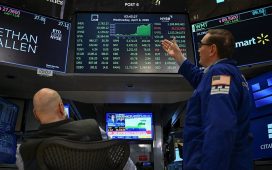Investors looking for income should be well-rewarded this year, once again, buying high-yield bonds, according to State Street. The assets outperformed last year, with the Bloomberg VLI High Yield Index beating the Bloomberg US Aggregate Bond Index by nearly 8% in total return, said Michael Arone, the firm’s chief strategist, in a note last week. He’s predicting high-yield bonds will again be one of the top-performing fixed-income sectors in 2024. “With the soft landing seemingly within our grasp, yields close to 8%, high interest coverage ratios, reasonably low default rates, and robust corporate profitability make high yield bonds an attractive total return option within fixed income allocations,” Arone said. USHY YTD mountain iShares Broad USD High Yield Corporate Bond ETF year to date So far this year, interest rate volatility has remained elevated, he said. That should continue amid confusion about the future path of monetary policy and the poor fiscal position of the United States, he predicted. The Federal Reserve has indicated it will decrease rates this year , but has said it is unlikely to start cutting in March. Right now, credit spreads remain very low. High-yield bonds currently have spreads of 3.43 percentage points relative to Treasurys, according to the ICE BofA US High Yield Index Option-Adjusted Spread . However, if the economy is in worse shape than expected and credit spreads widen, that could hurt his thesis, Arone told CNBC. “That said, earnings have been reasonably strong,” he said. “The economy continues to grow … it is hard to envision today why credit spreads would widen again.” Defaults are also below historical levels, he said. Meanwhile, yields are rewarding investors as they wait for bond prices to rise, he pointed out. Yields move inversely to prices. “Investors haven’t seen yields like this in years and so they are still able to capture a solid total return,” Arone said. “If rates fall as expected, even high yield will show some total return improvement as a result.” Of course, investors should understand that high-yield bonds carry more risk than investment-grade debt. Arone suggests avoiding more speculative credit and moving up in quality within high yield, even just below investment-grade. “They should be balancing the quality characteristics of high-yield bonds relative to the yield that those bonds are providing,” he said.












